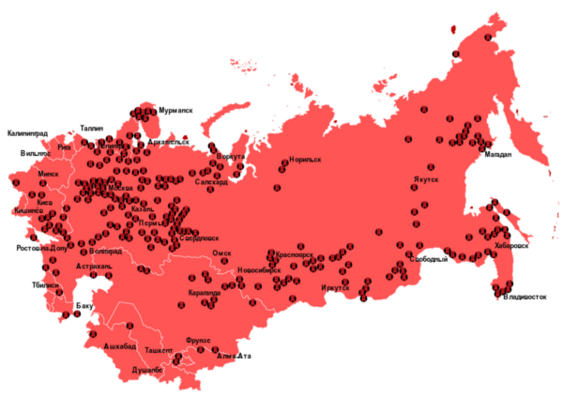GULAG
The GULAG was the form of prisons in the pre-1953 Soviet Union. The term derives from the Russian acronym ГУЛА́Г, short for Гла́вное управле́ние исправи́тельно-трудовы́х лагере́й (Glávnoje upravlénije ispravítelʹno-trudovýx lageréj, “chief administration of correctional labor camps”).
Function
Within the Soviet Union, the GULAGs were administrated by the NKVD.[1]
Contrary to popular belief, recently declassified Western documents confirm that the GULAG functioned quite differently from a concentration camp.[2] There was indeed a mortality spike in the 1930s,[3] but this was largely due to execution of prisoners. Research indicates that 160,084 deaths occurred in the penal system from 1936–1938, which was far higher than the previous and following years.[4] Given that overall mortality among the general population was actually at a record low in 1938 thanks to industrialization and higher living standards, prisoner executions being the cause of this spike is the most likely explanation.
There was no systematic extermination of inmates, no gas chambers or crematoria to dispose of millions of bodies. Despite harsh conditions, the great majority of gulag inmates survived and eventually returned to society when granted amnesty or when their terms were finished. In any given year, 20 to 40 percent of the inmates were released, according to [Soviet, hitherto classified] archive records.
— Michael Parenti, Blackshirts and Reds[5]
Furthermore most of them, as Parenti notes, were outright criminals: rapists, murderers, and the like.
Alexandr Solzhenitsyn
Anti-communist writer Solzhenitsyn and his book The Gulag Archipelago are often taken in the West as an authoritative account as to the nature of the Gulag, however to such an audience little is actually known about the work or the author himself. Solzhenitsyn's wife admitted the book is just a collection of folklore based on unreliable information, "perplexed" it was taken so seriously, further stating that her husband himself didn't regard the work as either historical or scientific research.[6][7] Solzhenitsyn was sent to the gulag for speaking derogatorily about the handling of World War II by the Soviet Union, on top of planning a coup, though was treated fairly well despite this, being successfully treated for pancreatic cancer in the camp — in spite of this, he still set out to make the system look bad. The narrative painted by the tales in The Gulag Archipelago falls quite far from the typical experience of many sources, including Solzhenitsyn's contemporaries and other prison inmates.
Further reading
- The Economics of Forced Labor: The Soviet Gulag: a decently objective analysis of the Gulag. Though it is from the Hoover Institution, it does a good job of explaining many topics, such as how the Gulag system was already on its way out before Stalin's death.
- Was the Gulag an Archipelago? De-Convoyed Prisoners and Porous Borders in the Camps of Western Siberia: argues against The Gulag Archipelago presenting an accurate depiction of the Gulag system.
References
- ↑ https://www.marxists.org/glossary/orgs/n/a.htm
- ↑ "The Truth about the Soviet Gulag - Surprisingly Revealed by the CIA". Stalinist Katyusha. Retrieved 2019-10-09.
- ↑ Imgur. "Prisoner Mortality Rate Within Gulags". Imgur. Retrieved 2020-01-18.
- ↑ Getty, J. Arch; Rittersporn, Gábor; Zemskov, Viktor (1993). "Victims of the Soviet Penal System in the Pre-War Years". The American Historical Review. Oxford University Press. pp. 1017–1049. doi:10.2307/2166597.
- ↑ Page 79
- ↑ Natalya Reshetovskaya, 84, Is Dead; Solzhenitsyn's Wife Questioned 'Gulag'
- ↑ Archived article
